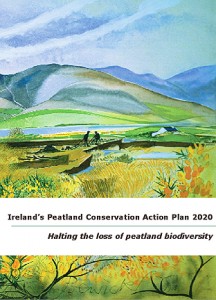 The Irish Peatland Conservation Council (IPCC) published our new action plan entitled Ireland’s Peatland Conservation Action Plan 2020 – halting the loss of peatland biodiversity during 2009. The aim of this plan is to develop a national strategy for the conservation and management of all peatland types in Ireland. The findings of the plan are as follows:
The Irish Peatland Conservation Council (IPCC) published our new action plan entitled Ireland’s Peatland Conservation Action Plan 2020 – halting the loss of peatland biodiversity during 2009. The aim of this plan is to develop a national strategy for the conservation and management of all peatland types in Ireland. The findings of the plan are as follows:
- 269,267ha of peatlands are of conservation interest in Ireland. This represents 23% of the original peatland area in the country.
- There are 736 peatland sites of conservation value in the Republic of Ireland and 138 peatland sites of conservation value in Northern Ireland.
- 129 actions are needed to conserve our peatlands and return degraded and threatened peatlands to favourable conservation status.
- The Irish Government have not yet completed the formal designation of peatlands of conservation value as Natural Heritage Areas and Special Areas of Conservation.
- 395 peatlands of conservation importance in Ireland have no formal conservation designation under national or international legislation.
- The key human activities leading to peatland habitat loss and degradation include turf extraction, afforestation, agricultural reclamation, overgrazing, the construction of wind farms on peatlands, tourism, trampling, dumping and burning. Drainage is associated with most of these activities.
- 40% of our peatland resources have been lost to turbary or turf cutting for domestic use, which represents the single greatest loss of habitat in Ireland.
- Every peatland of conservation importance listed in the plan is affected by turf cutting.
- Drainage and degradation of peatlands makes them to susceptible to colonization by invasive species including Rhododendron ponticum and Sarracenia purpurea.
- Drainage of peatlands is contributing to Ireland’s greenhouse gas emissions. A high water table must be restored to damaged peatlands if their greenhouse gas storage functions are to operate.
- Pollution of ground water may be leading to increased eutrophication of fen habitats.
- The marsh fritillary butterfly, red grouse, common frog, marsh saxifrage and whorl snails are considered to be indicator species of peatland health.
- Peatland management plans have been prepared for only 6% of the sites of conservation value. Peatland restoration work has only been undertaken on 9% of the peatlands of conservation importance.
The priority actions for peatland conservation in Ireland are set out in the table below:
| Priority Actions for Peatland Conservation in Ireland | Priority | Timescale On-going Short (0-3 years) Medium (3-5 years) Long (5-10 years) |
| The Irish Government need to formulate an integrated national peatland conservation policy and strategy which recognises the functions and values peatlands provide and their importance for biodiversity. This needs to be adequately funded so as to ensure its implementation. | High | Short |
| The Irish Government should acknowledge the national importance of peatlands as a major carbon store, the role of pristine and restored peatlands as carbon sinks, and the potential of degraded peatlands to enhance the greenhouse effect. Peatland conservation and restoration should be a priority of Ireland’s Climate Change Adaptation Strategy. | High | On-going |
| The Government need to publish guidelines outlining how to achieve favourable conservation status incorporating in particular measures to preserve, restore and monitor peatlands damaged by turf cutting. Implementation of the Cessation of Turf Cutting would be an integral part of the guidelines. | High | Short |
| Adequate funding needs to be provided by the Government for the restoration of threatened peatland sites, to create mosaics of wetland habitats in the wider countryside and to allow nature conservation agencies to engage in consultation with landowners in all designated sites. | High | On-going |
| Further research on peatlands is needed, especially research into the eco-hydrological functioning of blanket bogs so that appropriate restoration of this habitat can be carried out. Inventories of fens, heaths, cutover and cutaway bogs need to be undertaken so that valuable unprotected sites are designated for conservation or biodiversity. | High | On-going |
| The over exploitation of peatlands has shifted their ecology from being carbon sinks to being green house gas emitters. To meet Ireland’s Kyoto targets on carbon emissions the carbon sequestration function of peatlands needs to be restored through active management of the watertable. The burning of peat in power stations and private homes must be phased out and replaced with renewable energy technologies as part of a Government energy strategy. | High | Medium |
| Opportunities to create employment as a side effect of sustainable peatland conservation, management and restoration, especially in parts of the country with weak employment growth must be given priority. | High | On-going |
| The protection of designated sites should be the central focus of agri-environmental schemes such as REPS. | High | On-going |
| Legal protection for all peatland sites of conservation importance much be achieved. | High | Medium |
Source Citation
Malone, S. and O’Connell, C. (2009) Ireland’s Peatland Conservation Action Plan 2020 – halting the loss of peatland biodiversity. Irish Peatland Conservation Council, Kildare.
Expanding on the Content of the IPCC Action Plan 2020
Please follow the links below to further information from the IPCC Action Plan 2020.
Purchase
Copies of Ireland’s Peatland Conservation Action Plan 2020 – halting the loss of peatland biodiversity cost €25 and may be ordered from the Nature Shop
Text, Photographs and Images © Irish Peatland Conservation Council, Bog of Allen Nature Centre, Lullymore, Rathangan, Co. Kildare. Email: bogs@ipcc.ie; Tel: +353-45-860133.
